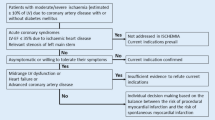Abstract
The aim of the study was to determine the proportion of high-risk patients who received appropriate antianginal therapy in the prodromal phase prior to a myocardial infarction, as an indicator of medical care seeking behavior. To this end, 606 male infarct patients aged 29–65 years were retrospectively interviewed 17–21 days after acute myocardial infarct. It was found that 77% of all patients (465/606) suffered from anginal pain, but only 32% of the patients with angina pectoris were receiving antianginal therapy in the prodromal period before acute myocardial infarction. Patients not taking medication were significantly younger than those with antianginal medication; they were more often smokers; they were less often suffering from high blood pressure; they expressed more pronounced nonacceptance of the risk; their history of anginal pain was significantly shorter; and they belonged more often to the patient group with a first myocardial infarction. In stepwise logistic regression analysis, high blood pressure, older age and exhaustion were found to be associated with medical treatment before infarction in the patient group with first myocardial infarction. In patients with recurrent infarction, continued smoking and denial of the risk remained predictive of nonmedication.
Zusammenfassung
Ziel der Studie wares, das Inanspruchnahmeverhalten medizinischer Dienstleistungen von Myokardinfarktpatienten am Beispiel einer antianginösen Therapie in der Prodromalphase vor dem akuten Ereignis zu erfassen. Hierzu wurden 606 männlichen Infarktpatienten im Alter zwischen 29 und 65 Jahren retrospektiv im Zeitraum 17–21 Tage nach dem akuten Ereignis befragt. Von diesen Patienten hatten 77% (465/606 Patienten) in der Prodromalphase an pektanginösen Herzschmerzen (AP) gelitten. Allerdings standen nur 32% der AP-Patienten (148/463 Patienten) unter einer antianginösen Therapie. Die Patienten ohne eine solche Medikation waren jünger, häufiger Raucher, sie wiesen weniger häufig einen Bluthochdruck auf, sie zeigten ausgeprägtere, Merkmale von Verleugnung, ihre Schmerzanamnese war hochsignifikant kürzer, und sie gehörten häufiger zur Gruppe der Erstinfarktpatienten als die AP-Patienten, die unter einer antianginösen Therapie standen. In der schrittweisen logistichen Regression der univariant signifikanten Diskriminatoren blieben für die Erstinfarktpatienten Bluthochdruck, höheres Alter und Psychoasthemie mit der Prämedikation assoziert. Für die Reinfarktpatienten waren wiederum fortgesetztes Rauchen und Verleugnung Prädiktoren für die Nichtinanspruchnahme medikamentöser Therapien.
Similar content being viewed by others
Literatur
Akhras F, Jackson G (1991) Efficacy of nifedipine and isosorbide mononitrate in combination with atenolol in stable angina. Lancet I: 1036
Becker MH, Maiman LA (1975) Socio-behavioral determinants of compliance with health and medical care recommendations. Med Care 13: 10
Borggrefe M, Schäfer J, Breithardt G (1990) Postinfarction late potential study (PILP-Study): prognostic significance of ventricular late potentials. Eur Heart J 11 [II Abstract Suppl]: 403
Breithardt G, Borggrefe M (1986) Pathophysiological mechanisms and clinical significance of ventricular late potentials. Eur Heart J 7: 364
Droste C, Greenlee MW, Roskamm H (1986) A defective angina pectoris pain warning system: experimental findings of ischemic and electrical pain test. Pain 26: 199
Gerstenkorn A (1990) The phenomenon of non-utilization of medical services by persons suffering from angina pectoris. Soz Praeventiv Mev 35: 206
Gillum RF, Feinleib M, Margolis JR, Fabsitz RR, Basch RC (1975) The pre-hospital phase of acute myocardial infarction and sudden death. Prodromata of acute coronary events. Prev Med 4: 408
Haisch J, Zeitler H-P, Besel K (1991) Symptomwahrenhmung, Krankheitsbewußstein, Arztkonsultation. MMW 133:224
Harper RW, Kennedy G, Santis, RW de, Hutter AM (1979) The incidence and pattern of angina prior to acute myocardial infarction. A study of 577 cases. Am. Heart J 97:178
Hoffmann A, Gutzwiller F, Dubach VC (1981) Häufigkeit und Art von Brustschmerzen bei ambulanten Patienten. MMW 123:1323
Kröger K, Schipke V, Thänner V, Heusch G (1989) Poststenotic ischaemic myocardial dysfunction induced by peripheral nociceptive stimulation. Eur, Heart J 10 [Suppl F]: 179
Ladwig K-H (1989) Patient-Arzt-Reaktionen auf spezifische und unspezifische Warnsignale in der Vorphase eines akuten Myokardinfarktes. Z Verhaltensmodifikation Verhaltensmedizin 3: 181
Ladwig K-H, Kraus-Keßler T (1987) Besonderheiten psychosomatischer Konfliktverarbeitung bei Frauen in der Vorphase eines akuten, Myokardinfarktes. In: Weidemann H (Hrsg) Die koronare Herzkrankheit der Frat. Steinkopff, Darmstadt
Ladwig K-H, Kieser M, König J, Breithardt G, Borggrefe M (1991) Affective disorders and survival after acute myocardial infarction. Eur Heart J 12:959
Ladwig, K-H, Kieser M, König J, Breithardt G (1992) Klinik und prognostische Bedeutung der Prodromalphase bei Patienten mit überlebtem akuten Myokardinfarkt MMW 134: 61
Levine J, Warrenburg S, Kerns R Schwartz G, Delaney R, Fontana A, Gradman A, Smith S, Allen S, Cascione R (1987) The role of denial in recovery from coronary heart disease. Psychosom Med 49: 109
Maseri A, Chierchia S, Davies G, Glazier J (1985) Mechanisms of ischemic cardiac pain and of silent myocardial ischemia. Am J Med 79: 7
Rose G Blackburn H (1968) Cardiovascular survey methods. World Health Organization Monograph Series No. 56, Geneva
Schmale AH (1972) Giving-up as a final common pathway to changes in healthy. Adv Psychosom Med 8: 20
Siegrist J (1988) Models of health behavior. Eur Heart J 9: 709
Simon H, Silberhorn M (1979) Die Prodromalsymptome bei akutem Myokardinfarkt. Dtsch Med Wochenschr 104: 573
Simson MB (1981) Identification of patients with ventricular tachycardia after myocardial infarction from signals in the terminal QRS complex. Circulation 64: 235
Stockle JD, Zola IK, Davidson GE (1964) The quantity and significance of psychological distress in medical patients. J Chron Dis 17: 959.
Tebbe V, Sauer G, Kreuzer H, Vogt A, Bethge KR, Weigand V, Neuhaus KL (1986) Akut-Koronarangiographie bei therapierefraktärer Angina Pectoris. Dtsch Med Wochenschr 14: 539
Theisen K, Angermann Ch, Silber S, Weber M, Jahrmärker H (1986) Überflüssige kardiologische Diagnostik. Internist 27: 552
Tillmanns H (1989) Prognose bei instabiler Angina pectoris. In: Nitroglycerin VI. Walter de Gruyter, Berlin New York, S 25
Zola IK (1972) Studying the decision to see a doctor. Review, critique, correction. Adv Psychosom Med 8: 216
Author information
Authors and Affiliations
Rights and permissions
About this article
Cite this article
Ladwig, K.H., Lehmacher, W., Roth, R. et al. Wirken sich pektanginöse Schmerzen auf das Inanspruchnahmeverhalten herzwirksamer Medikamente in der Prodromalphase eines akuten Myokardinfarktes aus?. Schmerz 6, 239–244 (1992). https://doi.org/10.1007/BF02527812
Issue Date:
DOI: https://doi.org/10.1007/BF02527812




